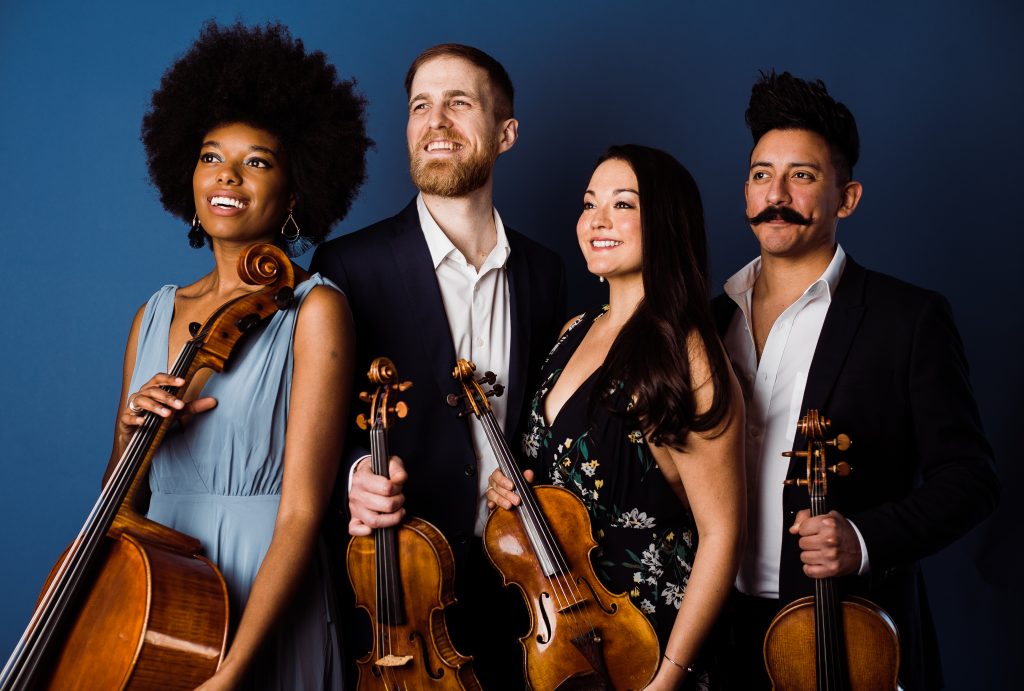
Oh, to be a member of a young string quartet nowadays.
A format that reached its first flowering in the days when leaders of Britain’s American colonies were looking for the exit sign is today a group synonymous with the kind of tight-but-exhilarating camaraderie that results from a small band of people attempting something Olympian while navigating concert-packed road trips and posting Instagram images of tasty lunches in beautiful foreign capitals.
That fantasy-reality depends on the four musicians involved, and judging by the way the members of the Thalea String Quartet interacted March 5 at the Flagler Museum in Palm Beach, I feel confident in being envious. The San Francisco-based quartet closed this season’s series of concerts at the Flagler, and they did so in entertaining and positive fashion in a program of canonical Austro-German works and two brief 20th-century American pieces.
The quartet, which has two Canadian members — violinists Christopher Whitley of Toronto and Kumiko Sakomoto of Medicine Hat — and two Americans, violist Luis Bellorín of suburban Chicago and cellist Titilayo Ayangade of Cincinnati, has been together only five years, but they’ve already racked up an impressive list of awards, residencies and collaborations. In concert, they are warm and engaging, each member taking turns talking about the music they’re going to play and what to listen for.
The group opened their concert before a good-sized crowd at Whitehall with the Quartet No. 26 (in G minor, Hob. III:33; also known as Op. 20, No. 3) of Franz Joseph Haydn, written in 1772. From the outset, the Thalea Quartet made a point of underlining motifs and marking them, such as the little nine-note unison tag that runs throughout the first movement. Married to a brisk tempo and an in-your-face tonal quality, the performance brought out all the wit that Haydn is celebrated for, but which is often subtle and easily glossed over. Here, it was a centerpiece of the quartet’s interpretation, and reminded listeners why Haydn continues to be a central part of the canon.
The intense slow movement gave cellist Ayangade (an occasional cast member of Fox’s Empire) a moment in the spotlight that showcased her demure, pretty tone, and the finale’s rapid tempo ended the quartet in a semi-comic way that stressed motifs as though they were characters in a drama. This was as fully committed a Haydn performance as one is likely to hear; even if one disagreed with the interpretive choices, you couldn’t gainsay the group’s absolute investment in the music.
The Haydn was followed by a rarity, the Movement for string quartet of Aaron Copland, written while he was in his 20s and living in France as the star pupil of Nadia Boulanger. It’s not often remembered how assiduous a student he was and how much Boulanger admired him, but this relatively brief piece, probably for an exercise, shows the young composer’s command of the modernist styles then defining contemporary composition outside the Second Viennese School: it’s music in the ambit of the neoclassicists.
Starting with a moody, expectant slow introduction, it breaks off into a darkly dramatic fast section dominated by march-like themes and a savage kind of vigor. Indeed, it presages the kind of music Dmitri Shostakovich would write when he embarked on his series of 15 quartets years later. It’s fascinating, well-written music that’s very different from the populist American style that made Copland beloved. The Thalea played it beautifully.
The last scheduled work on the program took up the second half: the second Rasumovsky Quartet of Beethoven (Quartet No. 8 in E minor, Op. 59, No. 2). This is one of the central pieces of the quartet tradition, and a real test for any foursome. The Thalea proved more than up to the challenge, especially in the long second movement, which requires a tremendous level of concentration if the music is not to sound disconnected. The third movement Minuet had a kind of swaggering quality carried over from the Haydn performance, and the Finale was very fast and expansive.
First violinist Whitley, who has to play a lot of this movement at the very top of his register, had trouble keeping those stratosphere notes in tune in the second half of the movement, which marred the proceedings somewhat. Still, this was a very enjoyable Beethoven, expertly played and passionately rendered.
The quartet received a loud ovation at the conclusion of the Beethoven, and followed with an encore: the first movement (“The Sentimental One”) of the Lyric Quartette, a three-movement portrait of his friends by the composer, the inexcusably neglected William Grant Still. This lovely cameo provided a warm nightcap for this excellent concert by a fine young quartet, and to another strong series of programs at the Flagler Museum.